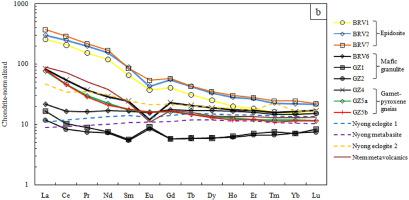当前位置:
X-MOL 学术
›
J. Afr. Earth Sci.
›
论文详情
Our official English website, www.x-mol.net, welcomes your
feedback! (Note: you will need to create a separate account there.)
Tectonic setting of the bipindi greenstone belt, northwest Congo craton, Cameroon: Implications on BIF deposition
Journal of African Earth Sciences ( IF 2.2 ) Pub Date : 2020-11-01 , DOI: 10.1016/j.jafrearsci.2020.103971 Cyriel Moudioh , Landry Soh Tamehe , Sylvestre Ganno , Marvine Nzepang Tankwa , Mariana Brando Soares , Rupam Ghosh , Boniface Kankeu , Jean Paul Nzenti
Journal of African Earth Sciences ( IF 2.2 ) Pub Date : 2020-11-01 , DOI: 10.1016/j.jafrearsci.2020.103971 Cyriel Moudioh , Landry Soh Tamehe , Sylvestre Ganno , Marvine Nzepang Tankwa , Mariana Brando Soares , Rupam Ghosh , Boniface Kankeu , Jean Paul Nzenti

|
Abstract The banded iron formations (BIFs) in the Bipindi greenstone belt (GB) are hosted within metavolcano-sedimentary sequence of the Nyong Group at the northwestern edge of the Congo Craton (Ntem Complex) in southern Cameroon. New data on the BIFs and its associated rocks allow us to discuss the tectonic setting of this greenstone belt in a regional perspective. Metavolcanic rocks consist of epidosites, mafic granulites, and garnet-pyroxene gneisses, whereas the metasedimentary rocks comprise chlorite-epidote schists. These rocks have been metamorphosed under greenschist-to granulite-facies conditions. The geochemical features of the metavolcanic rocks such as the trace element ratios and rare earth elements (REE) patterns suggest that their protolith corresponded to tholeiitic to transitional and calc-alkaline basalts. The associated metasedimentary rocks are characterized by low La/Sc and Th/Sc discrimination ratios, and REE abundances, indicating that they were derived from mafic and intermediate igneous rocks. Similar protoliths were recently described for metamorphic rocks interbedded with BIFs at the Nyong Group, which were formed in a shallow basin near the continent. The Bipindi BIFs are further characterized by both weak (1.31–1.34) and slightly high (2.00–2.51) positive (Eu/Eu)SN ratio, that are typical of Superior- and Algoma-type BIFs respectively. However, the geochemical features of the host rocks (e.g., REE patterns, Th/Nb, La/Yb, and La/Sc ratios) suggest that the Bipindi BIFs were deposited at an extensional geodynamic setting likely related to a back-arc, similar to the depositional environment for many Algoma-type BIFs. Archean-Paleoproterozoic arc setting is widely distributed across the Congo Caton and the West African Craton, suggesting integration of the tectonic evolution of the Bipindi GB into a continental-scale paleogeography.
中文翻译:

喀麦隆刚果克拉通西北部比品迪绿岩带的构造环境:对 BIF 沉积的影响
摘要 Bipindi 绿岩带 (GB) 中的带状铁地层 (BIF) 位于喀麦隆南部刚果克拉通 (Ntem 杂岩体) 西北边缘的 Nyong 群变质火山-沉积层序内。BIF 及其相关岩石的新数据使我们能够从区域角度讨论该绿岩带的构造环境。变质火山岩由绿帘石、镁铁质麻粒岩和石榴石辉石片麻岩组成,而变质沉积岩包括绿泥石-绿帘石片岩。这些岩石已在绿片岩至麻粒岩相条件下变质。变质火山岩的地球化学特征,如微量元素比和稀土元素 (REE) 模式表明它们的原岩对应于拉斑玄武岩到过渡和钙碱性玄武岩。相关变质沉积岩的特征是低 La/Sc 和 Th/Sc 辨别率,以及 REE 丰度,表明它们来自基性岩和中火成岩。最近在 Nyong 群与 BIF 互层的变质岩中描述了类似的原岩,这些变质岩形成于大陆附近的一个浅盆地。Bipindi BIF 的进一步特征是弱 (1.31–1.34) 和略高 (2.00–2.51) 正 (Eu/Eu)SN 比,这分别是 Superior 和 Algoma 型 BIF 的典型特征。然而,主岩的地球化学特征(如 REE 模式、Th/Nb、La/Yb 和 La/Sc 比率)表明 Bipindi BIF 沉积在可能与弧后类似的伸展地球动力学环境中许多 Algoma 型 BIF 的沉积环境。
更新日期:2020-11-01
中文翻译:

喀麦隆刚果克拉通西北部比品迪绿岩带的构造环境:对 BIF 沉积的影响
摘要 Bipindi 绿岩带 (GB) 中的带状铁地层 (BIF) 位于喀麦隆南部刚果克拉通 (Ntem 杂岩体) 西北边缘的 Nyong 群变质火山-沉积层序内。BIF 及其相关岩石的新数据使我们能够从区域角度讨论该绿岩带的构造环境。变质火山岩由绿帘石、镁铁质麻粒岩和石榴石辉石片麻岩组成,而变质沉积岩包括绿泥石-绿帘石片岩。这些岩石已在绿片岩至麻粒岩相条件下变质。变质火山岩的地球化学特征,如微量元素比和稀土元素 (REE) 模式表明它们的原岩对应于拉斑玄武岩到过渡和钙碱性玄武岩。相关变质沉积岩的特征是低 La/Sc 和 Th/Sc 辨别率,以及 REE 丰度,表明它们来自基性岩和中火成岩。最近在 Nyong 群与 BIF 互层的变质岩中描述了类似的原岩,这些变质岩形成于大陆附近的一个浅盆地。Bipindi BIF 的进一步特征是弱 (1.31–1.34) 和略高 (2.00–2.51) 正 (Eu/Eu)SN 比,这分别是 Superior 和 Algoma 型 BIF 的典型特征。然而,主岩的地球化学特征(如 REE 模式、Th/Nb、La/Yb 和 La/Sc 比率)表明 Bipindi BIF 沉积在可能与弧后类似的伸展地球动力学环境中许多 Algoma 型 BIF 的沉积环境。











































 京公网安备 11010802027423号
京公网安备 11010802027423号